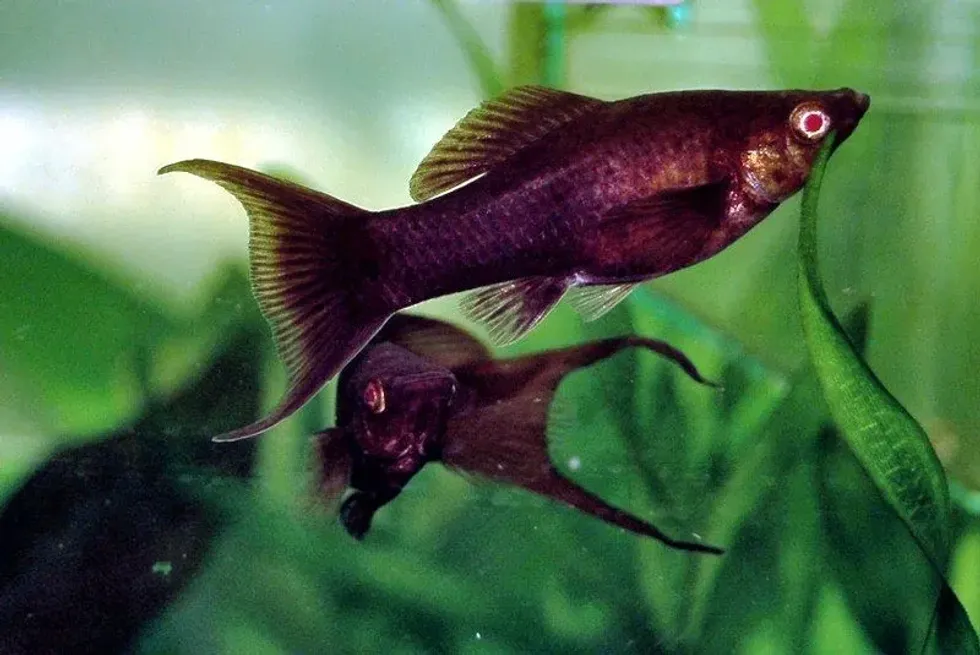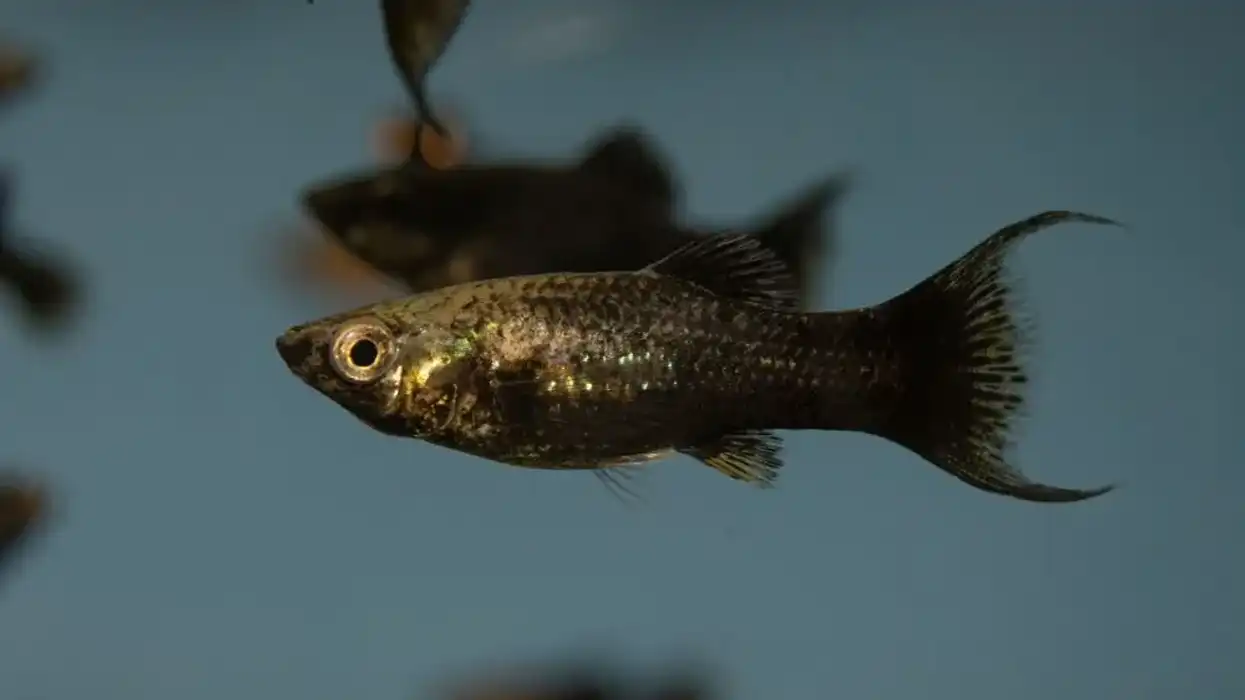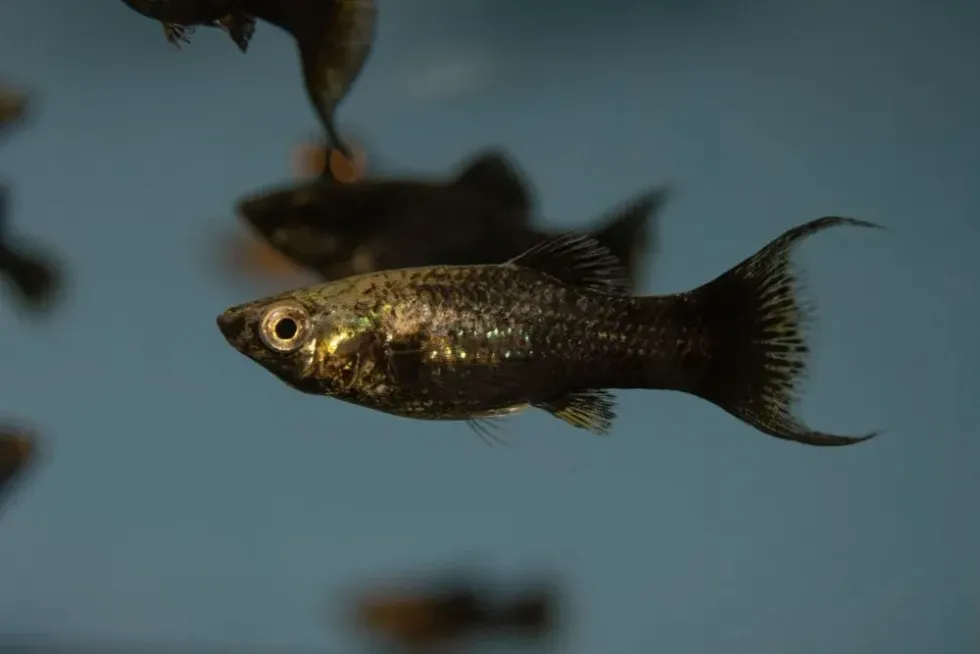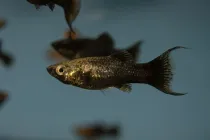Fun Black Molly Facts For Kids

Are you planning to assemble an aquarium and wondering if you should include a Black Molly in it or not? Well, our content here will clear all your doubts and help you to make a well-informed decision.
The Black Molly fish is hardy and predominantly freshwater fish though some species are known to live in brackish water. They are non-aggressive and get along with other mollies like Black Sailfin Molly, Black Lyretail Molly, and Balloon Molly fish.
They can also get along with other fish species like endlers, guppies, and swordtails. Domesticated Black Molly fish found in the market is primarily the hybrid variety obtained by breeding the Sailfin Molly and Short-finned Molly fish species.
These Black Mollies require aquariums with good quality water low in ammonia or nitrate contents.
Compared to other fish species, Black Molly fish care is effortless, and hence it is a popular fish in aquariums. One peculiar feature about this breed is that they are livebearers, giving birth to live young ones.
Read on to find out more about Black Molly fish. If you find this article exciting, check our content on the cownose ray and peacock cichlid.
Black Molly Interesting Facts
What type of animal is a black molly?
The Black Molly is a fish species that belongs to the Poeciliidae family. They are entirely black, but sometimes they might have a yellow line on their dorsal fin or silvery color on their sides.
What class of animal does a black molly belong to?
The Black Molly fish belongs to the class Actinopterygii and genus Poecilia.
How many black mollies are there in the world?
The exact number of Black Molly fish in the world is not known. But their numbers are likely huge as many breeders carry out their breeding since it is a popular fish for aquariums.
Where does a black molly live?
It is native to Central and South America, including Venezuela and Mexico. It is also found in Caribbean islands' brackish water and in Japan and Eastern Europe.
What is a black molly's habitat?
The Black Molly species' habitat is freshwater, brackish water, and seawater. They can live in wetlands, swamps, streams, and coastal areas. It prefers a tropical climate, and hence a water temperature ranging between 78-85 degrees Fahrenheit is considered ideal for this fish species.
Who do black mollies live with?
The Black Molly fish is a non-aggressive, peaceful community fish and can adjust peacefully with other community fishes. Some of the best Black Molly tank mates in an aquarium would be platies, guppies, swordtails, danios, gouramis, tetras, other mollies, and female betta fish.
How long does a black molly live?
The Black Mollies' lifespan, on average, ranges around three years in captivity. If it is taken care of well, then the Black Molly lifespan can extend to five years.
How do they reproduce?
When the male and female Black Molly fishes mate, the males deposit sperm into the females' vent. The females can hold these sperm for months together if they feel the conditions are not ideal for the birth of their young ones (fry).
It can become pregnant by fertilizing eggs from the stored sperm as often as 30 days, even when males are not present in the vicinity.
If conditions are ideal, the eggs are fertilized, and the gestation period is about seven to eight weeks.
They are known as ovoviviparous as the eggs are fertilized inside the female's body, and they give birth to 40-100 young ones (fry) at the end of the gestation period. You can tell that a female molly is pregnant by looking at its body which becomes boxy and a dark spot appears on its abdomen.
Pregnant Black Molly fish will lose their appetite a day or before they give birth, and they will also isolate themselves. The fry will start to swim soon after birth and can take care of itself.
It is important to remove the adult Black Molly fish from the tank after the birth of the young ones (fry), or else it may end up eating its young ones.
What is their conservation status?
There are plenty of Black Molly fishes around the world. This tropical fish has gained popularity as a Black Molly aquarium fish, and hence many breeders breed them at their breeding centers. Because of their large numbers, they are kept under the Least Concern category.
Black Molly Fun Facts
What do black mollies look like?
The entire body of the Black Molly fish is black, but sometimes a strip of yellow or silver runs across the dorsal fin or its flanks. They get their color due to overactive melanin in their skin, giving them a darker shade.
This molly fish can grow up to 6 in long under suitable conditions. They live in groups called shoals and are non-aggressive by nature.
It follows an omnivorous diet that eats both plant and animal varieties like algae, worms, larvae, and others. The male molly fish has a pointed anal fin called gonopodium, whereas the female molly fish has a triangular anal fin.

How cute are they?
Black Mollies are small and very attractive. Their dark-colored scales and small anal fin make their overall look very appealing.
How do they communicate?
The exact way by which Black Mollies communicate with each other is not available. But it is believed that like any other fish species, these also communicate via sound, motion, sight, and smell. They might communicate with each other for mating purposes, navigation, fighting, or alerting their peers about predators.
How big is a black molly?
The Black Molly size ranges from 2.3-6 in. If mollies are kept in aquariums with good-quality water and are given a high-quality diet, then this breed will grow up to its maximum length. Male mollies are smaller in size than female mollies.
How fast can a black molly swim?
The exact speed of Black molly fish is not available. But it is believed they are active and good swimmers. Hence they require a minimum of 20-gallon aquarium to swim around and will be more comfortable in a 45-gallon aquarium.
How much does a black molly weigh?
The weight of Black Molly fish varies widely depending on environmental and feeding factors. But, likely, they won't weigh more than a few ounces or grams owing to their small size.
What are the male and female names of the species?
The Black Molly fish male or female species do not have any specific names. They are known as male Black Molly fish and female Black Molly fish, respectively.
What would you call a baby black molly?
The Black Molly baby is known as Black Molly fry. The females fertilize the eggs inside their bodies and give birth to about 40-100 fries after a gestation period of eight weeks. These fries are quite independent of their birth and can look after themselves.
What do they eat?
The Black Molly follows an omnivorous diet. Its diet must include plant varieties like algae, zucchini, shelled peas, and cucumbers in captivity.
These mollies must be fed green vegetables once a week or sometimes twice a week. But their main diet must consist of high-quality flakes. Mollies can also be fed live or frozen varieties of bloodworms, daphnia, blackworms, shrimp, and mosquito larvae.
Are they dangerous?
This freshwater fish is a very peaceful community fish and gets along well with other peaceful tank mates.
Males are seen to be aggressive toward females during mating, and hence a 3:1 females and males ratio is maintained to protect the females from getting exhausted. Adult molly fish can prey on their young ones at times, and hence after it gives birth, the adult should be separated from the fry.
The Black Molly - Goldfish species combination does not make good tankmates in aquariums as the Black Molly fish can bully the Goldfish in an aquarium.
Would they make a good pet?
Black Mollies make excellent pets because of their peaceful and non-aggressive nature. They get along well with other peaceful community fishes like platies, guppies, swordtails, danios, gouramis, tetras, other mollies, and female betta fish.
Black Molly care is easy, but attention must be paid to water quality in the aquarium. A minimum 20-gallon aquarium will be suitable for a group of four molly fishes.
The ratio of females to males in the tank should always be 3:1 or 2:1, meaning a tank should have more females than males. The aquarium should have enough plants for the mollies to feel comfortable.
The pH of the water should be between 7.5-8.5, and the water hardness should be around 10-25 dH.
These mollies are extremely sensitive to temperature changes, and hence temperature should be maintained between 70-85 degrees Fahrenheit. A good diet of algae, vegetables, flakes, worms, and larvae would be ideal for its development and growth.
A good filter for purifying the water is a must for the aquarium, and it is vital for Black Molly's survival. A single molly fish costs around $2.99-$4 and can be easily obtained from any pet shop.
They are very friendly by nature and become very depressed when left alone in tanks. Hence they should always have the company of other compatible fishes or mollies or other livebearers.
Did you know...
Mollies are very popular tropical fishes that are often seen in aquariums. They come in black, orange, and green hues. Popular aquarium molly varieties include Sailfin, Dalmation, Black Molly, and Balloon molly fish.
The Black Molly is a hardy fish but is sensitive to water temperature and pH changes. An unclean tank may lead to Black Molly disease or shimmies, and affected species will swim or wiggle less and keep shimmying in one place.
They may develop reddened or purple gills, which could be a sign of ammonia or nitrate poisoning. A white film on the skin indicates fungal infection, and a pop-eye, sunken belly, and dropsy could be caused by polluted water or by some underlying diseases like fish TB.
Most of these diseases can be reversed by maintaining the temperature within the required range of 70-85 degrees Fahrenheit and the pH between 7.5-8.5. A good filter and regular cleaning of water in the aquarium can treat various fungal or protozoal infections.
Some diseases like fish, TB, and Velvet disease, among others, may require antibiotic treatment. Seachem ParaGuard can cure Ich or Ick, and adding copper medicine and nitrifying bacteria to the aquarium can cure diseases like swollen gills, red blood spots, and dropsy.
You would know your molly is dead if it stops swimming and floats on the surface of the water in the aquarium or lies down at the bottom of it. If it stops feeding and has sunken eyes, it is probably dead.
Another way to check if a fish is alive or not is to look at the gills or the body, and if there is no movement, then it is not alive.
How many black molly fish can live together?
The number of Black Molly fishes that are kept together in an aquarium depends on the size of the tank.
Typically in a 20-gallon tank, you can keep up to four Black molly fishes. The male-to-female Black Molly fish ratio should be 3:1 as the males have a strong sexual drive, and a lone female molly fish may soon get tired or sick of breeding or mating with the male counterpart.
If there is only one male and three females in the tank, then the attention of the male molly fish is distributed among all the females equally.
Can a black molly live in brackish water?
Some molly breeds do exceptionally well in brackish waters. This is due to their high adaptability, which increases their survival rate. But their capacity to survive in brackish waters doesn't mean they require salty water to survive. They can do well in freshwater habitats too.
Here at Kidadl, we have carefully created lots of interesting family-friendly animal facts for everyone to discover! Learn more about some other fish including Congo tetra or American shad.
You can even occupy yourself at home by drawing one on our Black Molly coloring pages.
We Want Your Photos!
More for You
See All
Bachelor of Science specializing in Human Anatomy

Joan AgieBachelor of Science specializing in Human Anatomy
With 3+ years of research and content writing experience across several niches, especially on education, technology, and business topics. Joan holds a Bachelor’s degree in Human Anatomy from the Federal University of Technology, Akure, Nigeria, and has worked as a researcher and writer for organizations across Nigeria, the US, the UK, and Germany. Joan enjoys meditation, watching movies, and learning new languages in her free time.
Bachelor of Journalism and Mass Communication

Ambuj TripathiBachelor of Journalism and Mass Communication
Ambuj is a skilled fact checker with a Bachelor's degree in Journalism and Mass Communication from Amity University. He has been recognized for his exceptional content writing skills, having won a CineMedia competition. In addition to his writing abilities, he also has a flair for design.
Disclaimer
1) Kidadl is independent and to make our service free to you the reader we are supported by advertising. We hope you love our recommendations for products and services! What we suggest is selected independently by the Kidadl team. If you purchase using the Buy Now button we may earn a small commission. This does not influence our choices. Prices are correct and items are available at the time the article was published but we cannot guarantee that on the time of reading. Please note that Kidadl is a participant in the Amazon Services LLC Associates Program, an affiliate advertising program designed to provide a means for sites to earn advertising fees by advertising and linking to Amazon. We also link to other websites, but are not responsible for their content.
2) At Kidadl, we strive to recommend the very best activities and events. We will always aim to give you accurate information at the date of publication - however, information does change, so it’s important you do your own research, double-check and make the decision that is right for your family. We recognise that not all activities and ideas are appropriate for all children and families or in all circumstances. Our recommended activities are based on age but these are a guide. We recommend that these ideas are used as inspiration, that ideas are undertaken with appropriate adult supervision, and that each adult uses their own discretion and knowledge of their children to consider the safety and suitability. Kidadl cannot accept liability for the execution of these ideas, and parental supervision is advised at all times, as safety is paramount. Anyone using the information provided by Kidadl does so at their own risk and we can not accept liability if things go wrong.
3) Because we are an educational resource, we have quotes and facts about a range of historical and modern figures. We do not endorse the actions of or rhetoric of all the people included in these collections, but we think they are important for growing minds to learn about under the guidance of parents or guardians.







